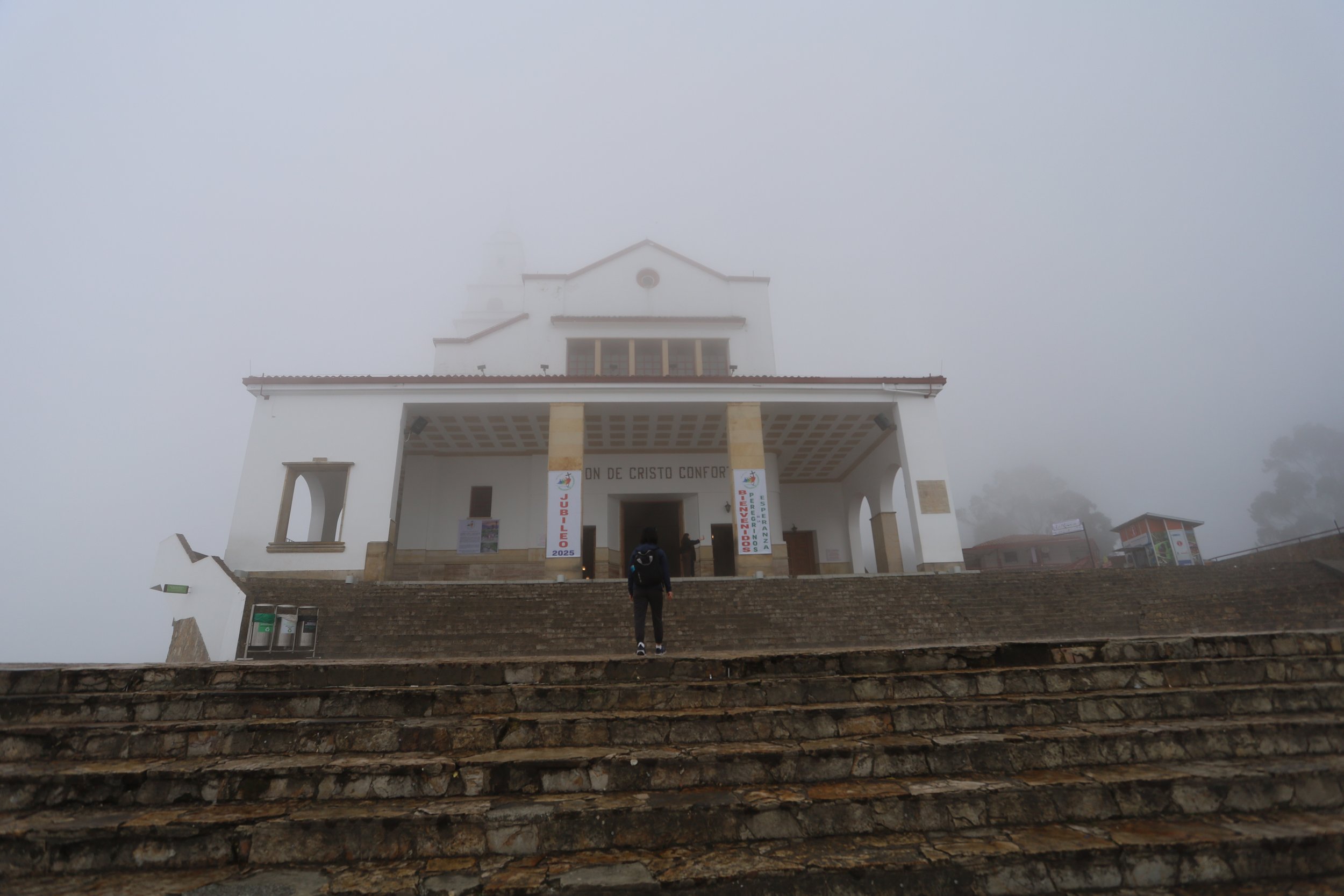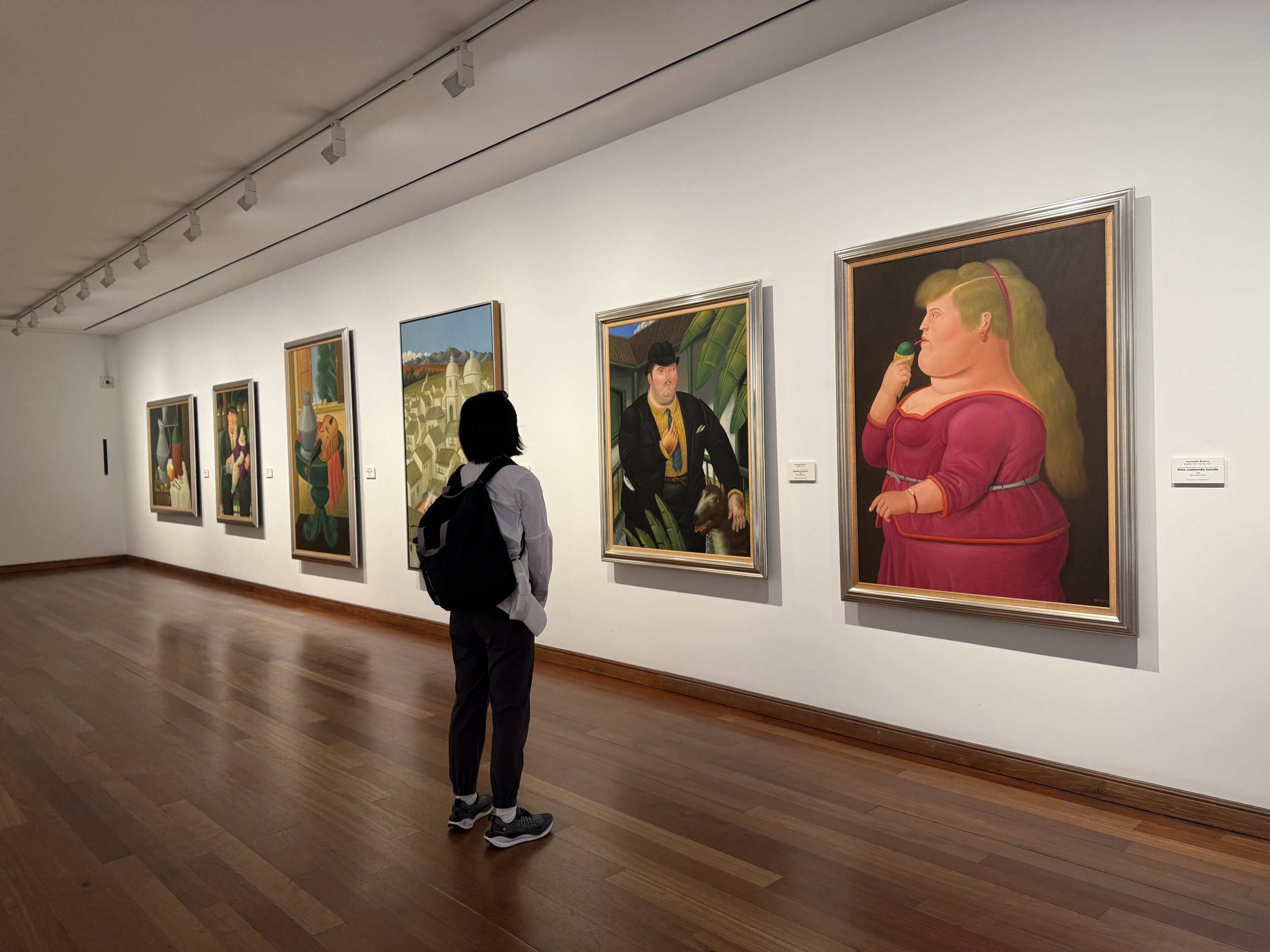Bogota, Colombia
Tres… Dos… Uno… Vamos! Aventuras sudamericanas!
We arrived in the city at 7:20 at night; N. had pre-arranged a taxi for a ride to our hotel downtown. The outskirts of the airport seemed a bit chaotic, what with families reuniting, tourists lost, and drivers hawking their taxis.
It was hard to get a pulse of the city, but the taxi driver seemed gentle and kind, saying in slow Spanish that he was honored we had come to visit his country.
We checked into a hotel close to the convention center — called “Agora Bogota”, which cracked me up — unpacked what we needed, and fell in bed, exhausted.
***
This is going to sound weird coming from a person who loves history — there was too much history on this walking tour!
We met a large group of people in front of the Museo del Oro. On time at 10 am.
As if on cue, N. piped up to say he needed a bathroom. The museum was closed on Mondays, so no luck there. At the guide’s suggestion — tour would begin at 10:10 am — we popped into a coffee shop nearby, bought a coffee and water — things that would cause us to want to go to the bathroom — to gain the privilege of using their bathroom. (Oh, Korea, we miss you!)
We started at Parque Santander and made our way to different stops in the neighborhood while our guide rattled off historical facts: the myth of El Dorado, whose location she claimed could only be confirmed to have been in Colombia because of a ceremony involving a boat ride to the center of a lake and lots of commemorative gold trinkets thrown in; the Chorro de Quevedo Square, which marks the first settlement of colonial period; the Emerald Market, safe to walk in, she said, because no one messes with the emerald cartel; the Bogotazo Riot, which let to the killing and looting and burning of many structures all over the country; and the Museo Botero, a beloved Colombian artist.
The one forgotten element on this tour was the most important thing that I learned in my teaching days: a presentation dense with facts must be leavened with enough entertaining asides to keep the audience engaged.
At the end of the tour, it started to rain and hail. We made our way to a nearby restaurant for lunch, where we had our first ajiaco santafereno, a traditional chicken soup from Bogota. The dish was a revelation: the broth thick with melting potatoes, shredded chicken and a small corn cob whose texture was thick and meaty. The soup was served with rice and a thick half avocado, milder, bigger and creamier than the rock hard ones we had at home. Oh, there was also the biggest fried fish we’d ever seen!
***
Should we stay or should we go? The skies looked cloudy and gray, but we decided to go to the Cerro de Monserrate all the same.
Our taxi dropped us off at the ticket booth as rain drops started to fall. After having read grumblings about the nightmare of figuring out which line to stand on — tickets for the funicular or the cable car; for the actual funicular or the cable car — we discovered the rain had magically shooed away all the smart people, leaving us a clear path for tickets and for the funicular itself. There was no view to be had — why with the clouds and rain — so we and our few funicular mates tried to enjoy the fast clip at which this little tram made its way up the mountain.
It wasn’t until we got off the tram and hiked the rest of the way up to the church at the summit that we realized that we were having to work mighty hard for each gulp of oxygen in our lungs. From an elevation of 2,640 meters/8,661 feet at city center, we had ascended to 3,152 meters/10,341 feet on the little tram.
N. and I went into the Iglesia Basilica del Senor de Monserrate (dating back to 1640), sat on the pews, contemplated the efforts of the faithful who built this church — without modern advantages of transportation or technology.
By the time we walked out of the sanctuary, the clouds had cleared just enough for us to see — like a miracle! — the sprawl of Bogota below.
We descended via cable car — the funicular was closed by then — and had to figure out what to do or where to go afterwards.
By a stroke of luck (or providence), we ended up walking towards the Candelaria neighborhood and were treated to lively streets, masses of young people out and about, and enough light in the late afternoon to enjoy the street graffiti.
***
The Museo Botero, the Miguel Urrutia Art Museum, and the Museo Casa de Moneda — entry to these interconnected museums was free — were great. But there was no informational desk nor pamphlets with guidance to the exhibits, which was not so great.
We wandered among the paintings, sculptures, and coins, admiring the art but struggling to put things in context.
We left when N. declared, “This is not bringing me joy anymore…”
We had made reservations for a day trip to the Salt Cathedral in Zipaquira through one of those travel apps.
However, the travel company running the tour contacted us to say that 1) the tour had only one other person signed up and so there was a chance it would be cancelled; but 2) that if we canceled with the travel app and booked directly with them, they could avoid the fees to the app and hence guarantee the tour.
Two thoughts crossed my mind: 1) this sounds like a questionable ethical practice; and 2) we would have no third-party involvement for the barest of safeguards; we would be in a car with an unknown driver in the countryside of Colombia without anyone else knowing where we were.
We canceled the tour. But not before the thought crossed my mind that I should give them a bit of a scare: tell the tour company that I worked for the travel app and that I was considering reporting them to corporate offices… Too mean?
I was content to look at some pictures of the Salt Cathedral online.
***
Around lunch time, we took a taxi to the Paloquemao Market, famous for fruits and flowers. My mistake was having high expectations because I had read a review in which a person said something like, “Oh, I came from Canada specifically to visit this market.” I mean, it must be amazing, right?
It was in a sketchy part of town. We could make that determination because we had to get off our taxi a block away — traffic was not moving — and we felt the need to hurry, with N.’s camera out of sight, to get out of the street and into the market itself.
Yes, fruit and vegetable vendors, flower vendors, meat vendors, and more were organized under one roof. The varieties of produce and products were interesting, but I always feel bad walking around a market without being able to buy anything to support the local people — what would I do with a whole fish or pounds of potatoes or kilos of papaya? N. is always less hesitant about these things, and he easily smiled and took pictures.
Unfortunately, our lunch at another well reviewed hole-in-the-wall demonstrated that crowd-sourced reviews need to be taken — always — with a grain of salt.
We went from there to museums.
First, the Museo del Oro. N. was considered a “senior citizen” (he liked the discount but not the classification) so his entrance fee was $0. It consisted of three floors full of pre-Colombian treasures — of clay, stone, and, well, gold. This museum did a better job than the Botero in providing informative plaques with descriptions and context for the art. Still, the overwhelming feeling as I was walking around the exhibits and looking upon piece upon piece upon piece was one of a visceral sense of my own ignorance about the history of this part of the world. I wished I had read a good overview before getting on the plane.
After our visits to the Museo Botero and the Muse del Oro, I have determined that N.’s tolerance for museums decreases rapidly after three hours.
So it was not a bad thing that we had only about 45 minutes to visit the Museo Internacional de la Esmeralda next door. We got a sense of what it might take to visit Fort Knox: they required our passports, took our pictures, gave us little white cards with which we went through the entry gates (just like going through a subway gate), went up an elevator escorted by one of the workers, paid COL 6,000 pax upon arrival at the 23rd floor, where we waited a few minutes before being led through the exhibits by a guide. We were not allowed to take pictures of the precious stones, so N. contented himself with taking pictures of the cloudy views outside the 23rd floor windows.
Although the guide claimed that, with few exceptions, all the emeralds in the display were real, the first part of the tour involved life-sized dioramas that looked like they were made by high school students with a 3-D printer. At the end of the tour, the guide literally deposited us at their emerald-selling gift shop. Overall, I believe we spent more time waiting for the tour to begin and wading through security than on the actual tour itself.
We had a final bowl of ajiaco and one tamal for dinner.
Adios, Colombia!







































